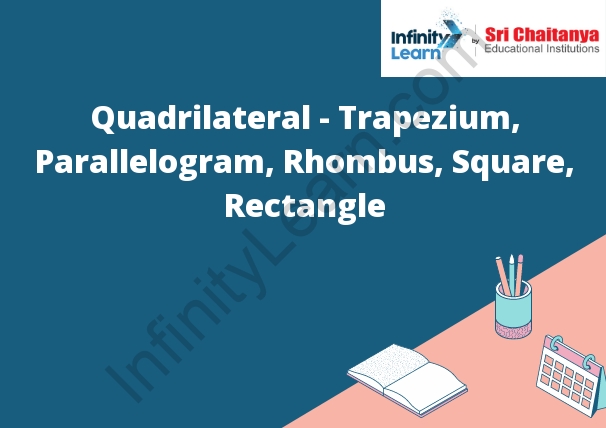Table of Contents
What is a Quadrilateral?
A quadrilateral is a polygon with four sides.

Facts About Quadrilaterals
A quadrilateral is a polygon with four sides. A square is a special type of quadrilateral, but there are other types of quadrilaterals, too.
Some quadrilaterals have two pairs of parallel sides. These are called parallelograms. Some quadrilaterals have one pair of parallel sides and two pairs of non-parallel sides. These are called trapezoids. And some quadrilaterals have all four sides of different lengths. These are called rectangles.
Quadrilateral
A quadrilateral is a polygon with four sides and four angles. The angles can be right angles, acute angles, or obtuse angles.
Trapezium
A trapezium is a quadrilateral with four sides, two of which are parallel. The other two sides are not parallel and are usually shorter.
Properties of Trapezium
The following are some important properties of a trapezium.
1. The four sides of a trapezium are not equal in length.
2. The two shorter sides are called the “base” and the “height”.
3. The angles at the base are called the “angles at the base”.
4. The angle at the top is called the “angle at the vertex”.
Important Formulas Related to Trapezium
A trapezoid is a quadrilateral with two parallel sides. The two parallel sides are called the bases, and the other two sides are called the legs. The height of a trapezoid is the distance between the two bases. The area of a trapezoid is the sum of the areas of the two trapezoids that have the same base and height.
Parallelogram
A parallelogram is a quadrilateral with two pairs of parallel sides.
Properties of Parallelogram
A parallelogram is a quadrilateral with two pairs of parallel sides.
The opposite angles of a parallelogram are equal.
The diagonals of a parallelogram bisect each other.
Important Formulas Related to Parallelograms
-Area of a parallelogram: A = bh
-Base of a parallelogram: b
-Height of a parallelogram: h
Rhombus
A rhombus is a parallelogram with four equal sides.
Properties of Rhombus
The following are some of the important properties of rhombus.
1. A rhombus is a quadrilateral with all four sides equal in length.
2. The angles of a rhombus are all equal to 60 degrees.
3. A rhombus has four angles of 90 degrees.
4. The diagonals of a rhombus are perpendicular bisectors of each other.
Important Formulas for Rhombus
A rhombus is a parallelogram with four equal sides. The formula for the area of a rhombus is A = b × h, where b is the base and h is the height.
Rhomboid
Rhomboid muscles are a pair of muscles that lie on either side of the spine, between the shoulder blades. They are responsible for moving the shoulder blades and helping to lift the arms.
Rectangle
A rectangle is a four-sided figure with two parallel sides and two equal angles.
Properties of Rectangle
A rectangle has the following properties:
– It has four sides and four angles.
– It has two diagonals which intersect at a 90 degree angle.
– Its length and width are both positive integers.
– The sum of its length and width is equal to its perimeter.
– The area of a rectangle is equal to its length multiplied by its width.
Important Formulas for Rectangle
Area
A rectangle’s area is the product of its length and width.
A = lw
Square
In mathematics, a square is the result of multiplying a number by itself. The result is an algebraic equation with an equal number of terms on each side of the equals sign.
Properties of a Square
A square is a four-sided polygon with all sides and angles equal. A square has four right angles, four interior angles of 90 degrees, and four exterior angles of 90 degrees.
Important Formulas for Squares
a = a ^ 2
b = b ^ 2
c = c ^ 2
a ^ 3 = a * a * a
b ^ 3 = b * b * b
c ^ 3 = c * c * c
Properties of a Kite
A kite has four properties: shape, stability, lift, and drag.
The shape of a kite is an airfoil. This shape helps to create lift, which is the force that keeps a kite in the air. Stability is the property that helps a kite stay in the air even when the wind changes directions. Lift is the force that keeps a kite in the air, and drag is the force that resists the motion of a kite.
Important Formulas for Kite
Area
Kite area is the area enclosed by the kite’s outline. The following formulas can be used to calculate the kite area.
Kite area = 1/2bh
Kite area = (1/2) * (base) * (height)
Classification of a Quadrilateral
A quadrilateral is a shape with four sides. It can be classified as a rectangle, square, trapezoid, or parallelogram.
Important Facts About Quadrilaterals
There are four types of quadrilaterals: squares, rectangles, parallelograms, and trapezoids.
A square is a rectangle where all four corners are right angles.
A rectangle is a square where the length and width are the same.
A parallelogram is a quadrilateral where two opposite sides are parallel.
A trapezoid is a quadrilateral with one pair of parallel sides.









